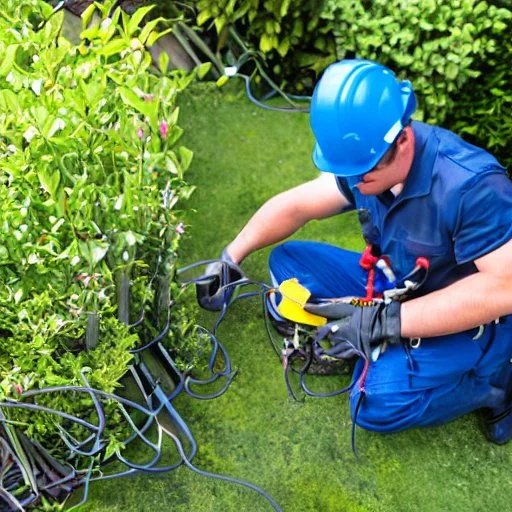July 19, 2025

The installation of outdoor electrical wiring is a tricky task that requires planning, skill and knowledge. It's important to know how to do this safely so the wiring is installed correctly. This article gives an overview of how to install outdoor electrical wiring properly, starting with gathering the materials needed and finishing with testing your work. It's important to be careful throughout the process as incorrect installation can cause damage or injury and create safety hazards. Therefore, it's recommended that individuals seek professional help when attempting any complicated electrical project. Overall, proper installation of outdoor electrical wiring is crucial to avoid dangerous situations, so readers are advised to pay close attention to each step in this article.
Gathering the necessary materials for outdoor electrical wiring is a crucial step in ensuring a safe and successful installation. It's essential to use high-quality materials that are weatherproofed to protect against potentially damaging elements. Outdoor electrical wiring should include an insulated copper wire of appropriate size and length, connectors, and switches rated for outdoor use. All components must be fastened securely together with screws or bolts designed for electrical connections to prevent corrosion over time. Establishing a ground connection between all devices and equipment is also vital and can be done using grounding rods or other approved methods. Having these materials on hand before starting the outdoor electrical wiring process will speed up the job and increase safety by allowing proper precautions to be taken throughout the entire installation process.
Determining the path of the wiring is a crucial step in the installation process. When planning your route, it is important to consider several factors in order to ensure a safe installation.
Firstly, it is important to avoid installing overhead wires as this can pose safety and aesthetic issues. Instead, underground paths should be chosen whenever possible. This can help reduce the risk of tripping hazards from exposed wires as well as improve the overall appearance of your property.
Furthermore, before beginning work on any project involving underground wiring, it is vital to ensure that all necessary permits have been acquired. By taking these steps, you can have peace of mind knowing that all safety regulations are being followed and that any potential risks associated with electrical wiring are minimized.
Once the route has been planned, the next step is to start digging a trench for the wiring. In most cases, the trench should be at least six inches deep to fully insulate cables and other components from ground and moisture contact. Depending on local regulations, there may also be restrictions on how far away from structures such as walls or fences you can dig your trench. While digging, it's important to avoid disturbing tree roots to prevent damage to existing plants and trees.
When installing cables outdoors, it's essential to use waterproofing techniques to protect electrical components from water seepage and other external elements. This can include applying protective sealant around any fittings or connections made during cable installation and ensuring a secure fit by burying them deeply within the trench wall. If multiple layers of electrical cable are being laid down in a single conduit system, it may be necessary to use additional waterproofing measures, such as wrapping them with plastic sheeting before installation.
Carefully laying the cables in the trench is crucial to ensure proper installation of wiring. It is recommended to use specialized tools like pliers, screwdrivers, and wire cutters for this task. It is also important to consider weather conditions as holding the electrical cables in place can be challenging during extreme temperature drops or humidity rises. Therefore, taking all these factors into account during outdoor wiring installation can prevent expensive repairs later on. Additionally, having a backup plan for inclement weather can save time and money on future wiring projects.
Testing the connections and circuit breakers is a crucial step in ensuring successful completion of outdoor electrical wiring projects. Inspecting the quality of the work done is paramount in order to ensure everything runs smoothly after installation.
This includes verifying that all wires are securely connected to their respective outlets, making sure that all insulation is intact, and checking for any exposed wiring. Furthermore, it is important to check if the circuit breaker has been properly calibrated. Connecting outlets with switches or other electrical receptacles should also be checked for proper function.
All of these steps help guarantee safe operation when dealing with outdoor electrical wiring projects. Once testing has been completed, a final inspection should be conducted in order to double-check all aspects of the project and make sure everything works correctly.
This involves checking all fixtures, turning on each switch or outlet one by one to ensure proper power supply, and verifying connection integrity for all components such as lights or fans. Any issues found during this process should be addressed immediately before allowing use of the system.
By following these steps carefully, you can rest assured that your outdoor electrical wiring project will be installed safely and correctly without any problems down the line.
The installation of outdoor electrical wiring can be a tricky task. However, with proper knowledge and planning, it can be done safely.
It's crucial to understand the local building codes to ensure the installation meets all safety requirements. Before starting the project, make sure to gather all the necessary materials.
Planning out the route for the wiring is also essential to avoid any obstacles or issues along the way. Finally, digging and installing the wiring should be done according to best practices to guarantee a successful job.
After completing these steps, testing should be done to ensure everything is working properly and safely. With careful consideration of all these factors, outdoor electrical wiring can be installed without any incidents or harm.